Wildlife

Wildlife |

|
|
Fish |
|
|
|
A few of the fish in their temporary home.They seem quite at ease and, interestingly, far less timid than in the open. The warm weather makes them more active than of late and even allows us to feed them a little. Of course, I forgot to count them from the pond to the tank, but I'll get them on the way back! |
|
Frogs |
|
Whilst moving the fish, several frogs and a toad were also moved. An adult on the left and a thumbnail sized youngster on the right with a pond skater. |
|
Toads 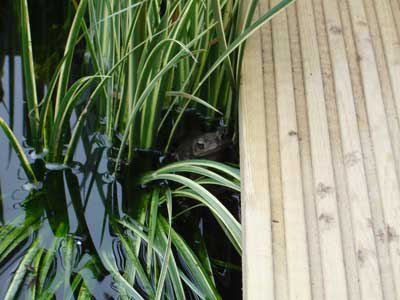 |

|
|
We found this one walking around the patio one day and popped him into the pond. He found his way (only males croak) into the corner grass and spends most of the day there hopping onto the side in the evenings. |
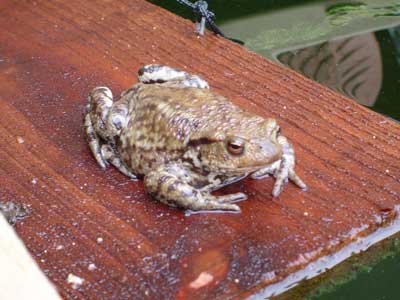
|
|
We are now very confused. We found another toad in an old bag of sand and popped it into the pond. A couple of days later we found this fine toad specimen in the pond, but it is much larger. One theory is that the 'sand' toad was dehydrated or emaciated, being trapped in the bag after hibernation. Once in the pond, it recovered its full size very quickly. Either that, or we have three toads! |
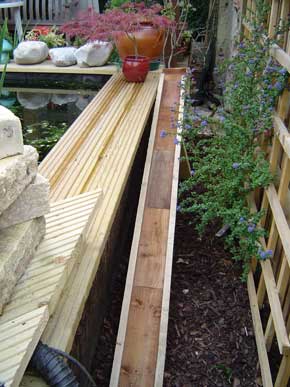
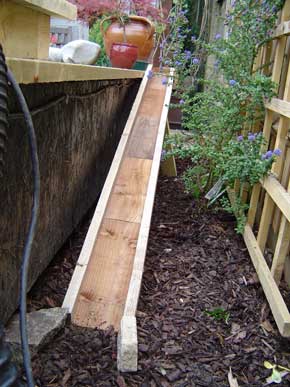
|
|
We are not sure if it will be used, but until there is some other way, we have built a ramp at the rear of the pond. Since installing it, we have sighted a newt, but it could equally have climbed in itself. |
|
Parakeets |
|
Although often seen (and heard) flying over the garden, this is the first time we have seen them IN the garden. One bird is tucking into the peanuts, while the other samples the white berries on the Sorbus Kashmiriani. (see later) |
|
Damsels 
|
|
We've had Damsel flies on the pond since the very beginning. They just appeared - as they do. We have standard red, blue and green variations. After hatching, they live as nymphs in the water for 2-3 years then climb up a plant stem to metamorphasise into the beautiful flying creatures that hover and dance around the pond. It is rare to see the transformation and I'd just missed it in this shot, but it's still interesting to see the nymph casing next to the adult. The damsel doesn't appear to have developed one of the colours yet. |
|
Woodpecker 
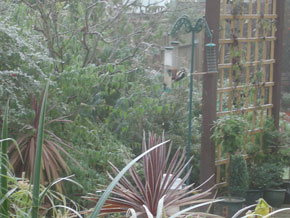
|
|
Both green and spotted varieties are common in the area, but we've only had spotted woodpeckers in the garden, and only in the winter. |
|
Parakeets 2 (Dec 2007) 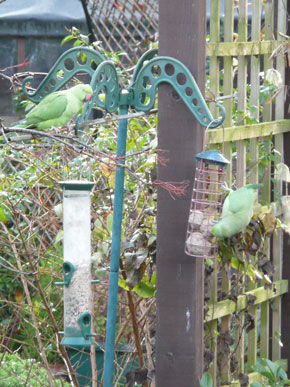

|
|
2 more Parakeets, but this time, the 10x zoom of the new Lumix camera comes into its own. |
|
Robins 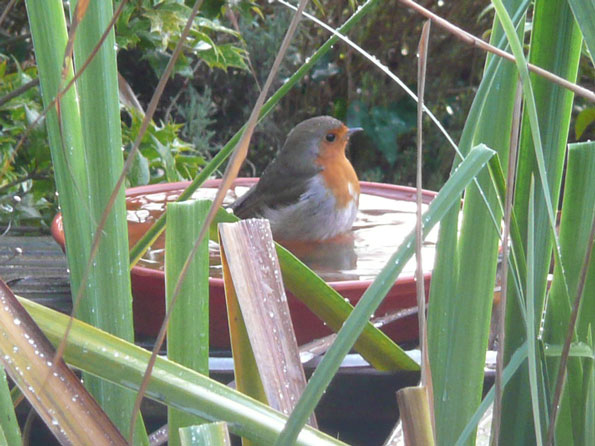
|
|
Two Robins during the mating season and single Robins the rest of the time are the norm. The youngsters are also to be found - sparrow like, but rooting around the ground and often less shy than the adults. |
|
Herons! 
|
|
We had the occasional problem with herons on the old pond, but not until now (February 2008) has one been seen on the new pond. He can't get at the fish from the edge, but murky water one morning means he's probably got down onto the plants and may have taken some. It's not possible to tell, because they are no where to be seen at present. And would we notice if a few dozen disappeared? I doubt it. |
|
Leaf cutter bees 
|
|
July 2008 - We only noticed these holes in the wisteria recently, but knew what made them - leaf cutter bees. They are solitary bees that line their nests (holes in trees or the ground) with circles of leaf. The leaves have to be a certain thickness and stiffness and roses are a favourite, but wisteria obviously fits the bill too. (bee photo from Wild Britain) |
|
Stag beetle 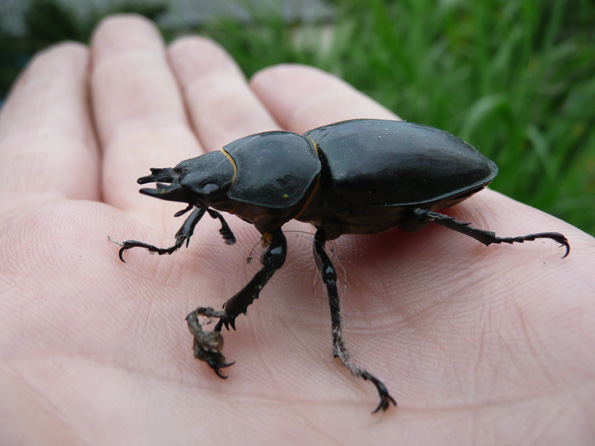
|
|
July 2008 - We've been told that stag beetles only come out in May, but this female(?) doesn't seem to know it. She was found on the kitchen wall one day and was moved to a log pile at the bottom of the garden. When cutting down the old apple tree before it fell down, several beetle larvae were found in the base, so most of the trunk was placed under large shrubs. This could be one of ours! |
|
Any ideas?  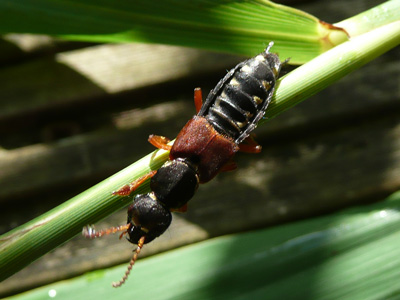
|
|
August 2008 - We were stumped on this one. It fell off one of the reed stalks onto the side of the pond and scuttled off under the paving slabs. We tried to look it up but drew a blank. However, a photo was submitted to the Natural History museum for identification on their web site Bug Forum. A couple of days later an answer was supplied. It was a Rove Beetle and, due to it's size of a good 25mm long, it's probably an Imperial Rove Beetle (Staphylinus caesareus).We'll probably never see it again! |